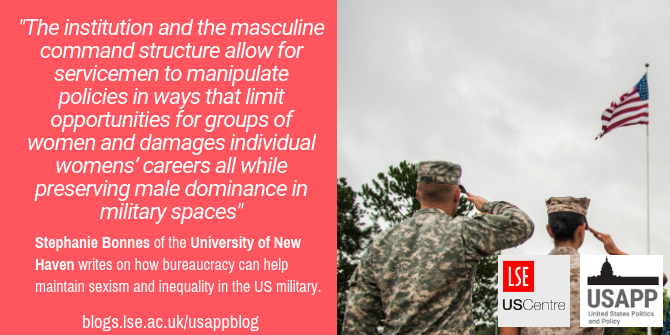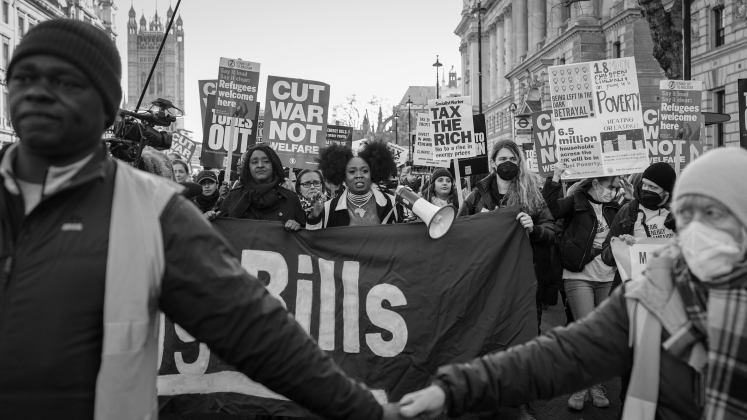 Five years ago the US military’s long-standing ban on women in ground combat was lifted. But, writes Stephanie Bonnes, the ‘bureaucratic harassment’ of women has meant that many policies that have been rescinded have continued. Using in-depth interviews with US servicewomen, she finds that servicemen are able to manipulate bureaucratic policies to harass and undermine women and their careers, allow sexual assaults to continue, and to preserve male dominance in the military.
Five years ago the US military’s long-standing ban on women in ground combat was lifted. But, writes Stephanie Bonnes, the ‘bureaucratic harassment’ of women has meant that many policies that have been rescinded have continued. Using in-depth interviews with US servicewomen, she finds that servicemen are able to manipulate bureaucratic policies to harass and undermine women and their careers, allow sexual assaults to continue, and to preserve male dominance in the military.
In 2012, four service-women sued the Department of Defense over the combat exclusion policy, the policy which officially excluded women from competing for and holding positions in combat units, despite women experiencing combat situations and being unofficially deployed in combat units as members of the lioness program or female engagement teams. In response to the lawsuit, in 2013 the then Defense Secretary, Leon Panetta announced the decision to lift the ban on women in ground combat. Since then, the military has been integrating units that were previously men-only. Additionally, many military branches have been adopting more inclusive policies such as the Navy’s changing hair standards, and gender neutral terms to describe job titles. All of these changes are needed and important steps in creating a more inclusive military workplace. However, my research shows that harassment and harm can be caused through the active manipulation of the military’s bureaucracy and policies. Further, what I call “bureaucratic harassment’ can be used to unofficially continue repealed policies such as the ban on women in combat, Don’t Ask Don’t Tell, and the recently repealed ban on transgender people in service (which President Trump already wants to reinstate).
How can bureaucracy be used to continue these policies of exclusion and inequality? I answer this question using data from in-depth interviews with US servicewomen. I use the term “bureaucratic harassment” to define workplace harassment in which bureaucracy is both a source of power and a tool of harassment perpetrators use to cause harm. Servicemen are able to manipulate bureaucratic policies due to both the strict hierarchy of the military and the high levels of discretion afforded commanders. For example, servicemen often threatened to withhold earned military benefits such as leave, awards, or deployments, postponed women’s promotions, transferred women out of units or positions, and built paper trails of petty infractions to try to permanently end servicewomen’s careers. One serviceman used bureaucratic harassment when he found out a woman who worked for him, and who he had previously flirted with, was marrying an officer. Maura’s commander chose to punish her through the bureaucratic system by manipulating her performance evaluation:
He gave me scores that were one off from what I needed to be promoted. It would take me forever to make rank at that point with those scores. he was mad at me because I was leaving and marrying an officer and he saw me as traitor for marrying an officer as an enlisted . . . you know, and he was an enlisted.
This kept Maura at a lower pay grade and made her look like a poor service-member since she was slow to promote. Since commanders have discretion in evaluations, Maura had no way to prove that her score was related to her personal relationship choices. Another servicewoman tried to report a sexual assault she experienced in the military barracks. Her commander told her that she would lose her Christmas leave if she reported as she would be required to stay on base while they investigated. She said, “It was clear that this was a threat. I was asked, ‘Do [you] really want to ruin this man’s career? If we have to go forward, we will have to cancel your leave.’” She dropped the report because the thought of being stuck on base where the perpetrator was also present made her too uncomfortable. Her commander silenced her sexual assault report through manipulating his power to grant and take-away privileges, again without having to document a reason.

U.S. Air Force photo by Airman 1st Class Harry Brexel
Bureaucratic harassment can also be used to undermine groups of women. For example, even though women were officially banned from combat until 2015, the military often “attached” women to combat units for short periods of time, “unofficially” deploying them into combat to circumvent its own policy. The Female Engagement Team (FET) is one model of all-women units designed to be attached to infantry units in combat zones. One of my participants, Olivia, had been on a FET and saw that the teams were limited in their decision-making power when in combat zones because they were headed by a sergeant, an enlisted rank, while male infantry units were headed by officers such as lieutenants, captains, and majors. Due to the strict military hierarchy, FET team leaders could not negotiate with these higher-ranking officers, nor could they make financial decisions for their teams. Therefore, Olivia recommended the teams be led by an officer at the rank of lieutenant to give FET more power in combat zones. Olivia’s major, who had previously said to her, “It would be a disaster to have women in the infantry” blocked this policy change, limiting the success and power of groups of women and preserving male dominance in combat decision-making. His power in the military hierarchy and his ability to make and block policies at his discretion, allowed for him to enact his sexist views through bureaucracy. Olivia explains:
I fought this policy because I felt like it was made for sexist reasons. This man had said so many times that he didn’t think women should be in the infantry and that they weren’t capable. The decision [not to attach lieutenants to each team] wasn’t made to better the FET team or to help the mission or even to ensure the safety of my Marines.
In spite of her experience leading a prior FET deployment, Olivia was fired from her position as the executive officer and dismissed from the unit, just a week before they deployed. She states: “So anyway, then they called me into the office and basically . . . they just told me I would no longer be going on the deployment. That’s when they said, “You are mutinying,” [and] they kicked me off.” Despite the sexist implications of the major’s decision, Olivia is the one who is officially punished. Standing up for the policy and attempting to expose a sexist action is interpreted as an act of rebellion for stepping outside of the military hierarchy. This shows that the institution and the masculine command structure allow for servicemen to manipulate policies in ways that limit opportunities for groups of women and damages individual womens’ careers all while preserving male dominance in military spaces.
Bureaucratic harassment can be used to continue banned polices and promote and reinforce inequalities even though it is technically against the rules. The interplay between organizational structures such as hierarchy and discretion, gendered and unequal workplace climates, and the active manipulation of institutional policies allows for harassment to flourish undetected.
While the military has implemented many new policies to address inequality, harassment, and sexual assault, without examining its culture, power structures, and bureaucratic features, those who wish to block the success of these policies or wish to inhibit the careers of individual service-women will remain able to do so through bureaucratic harassment.
- This article is based on the paper, ‘The Bureaucratic Harassment of U.S. Servicewomen’, in Gender & Society.
Please read our comments policy before commenting.
Note: This article gives the views of the author, and not the position of USAPP – American Politics and Policy, nor the London School of Economics.
Shortened URL for this post: http://bit.ly/2Q6xqLZ
About the author
 Stephanie Bonnes – University of New Haven
Stephanie Bonnes – University of New Haven
Stephanie Bonnes is an Assistant Professor of Criminal Justice at the University of New Haven. Her research broadly focuses on gender and race at the intersections of victimization, inequality, crime, and organizations. Her current project explores the experiences of women in the United States Military including, but not limited to, servicewomen’s experiences with sexual abuse.







1 Comments